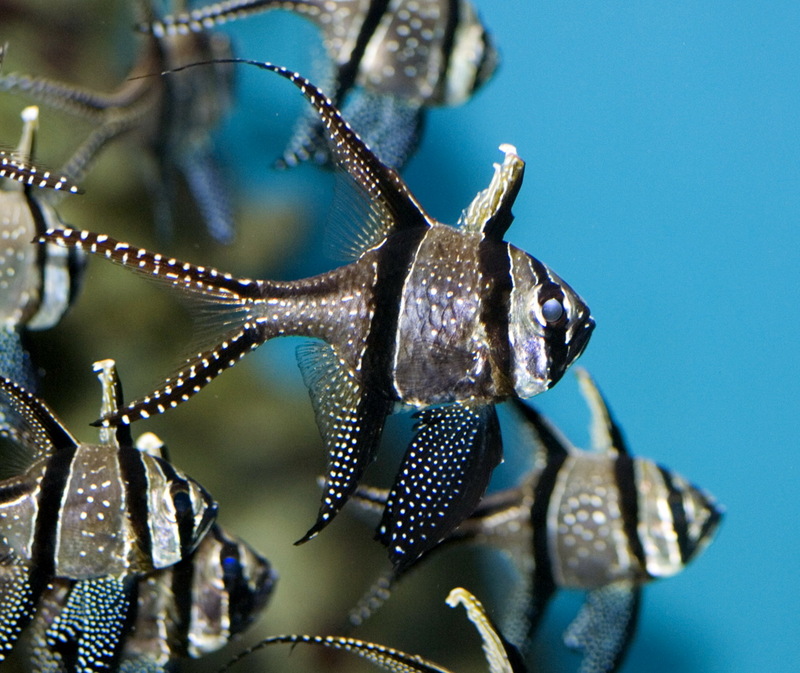Banggai cardinalfish
From Wikipedia, the free encyclopedia
[Photo] Pterapogon kauderni, Banggai cardinal fish. Date August 5, 2006. Author jon hanson from london, UK http://www.flickr.com/people/61952179@N00
The Banggai cardinalfish (Pterapogon kauderni) is a small tropical cardinalfish (family Apogonidae). This attractive fish is popular in the aquarium trade.
Distribution
This species is restricted to the Banggai Islands of Indonesia. This species has an extremely limited geographic range (5,500 km²) and small total population size (estimated at 2.4 million). The Banggai cardinalfish is composed of isolated populations concentrated around the shallows of 17 large and 10 small islands within the Banggai Archipelago. A small population also occurs off Central Sulawesi, within Luwuk harbor. One additional population has become established in the Lembeh Strait (North Sulawesi), 400 km north of the natural area of the species distribution, following introduction by aquarium fish traders in 2000.
Description
This species grows up to 8 centimetres (3 in) total length. It has a distinctive contrasting pattern of black and light bars with white spots. This species is easily differentiated from all other cardinalfish by its tasseled first dorsal fin, elongate anal and second dorsal fin rays, deeply forked caudal fin, and color pattern consisting of three black bars across the head and body and prominent black anterior edges on the anal and second dorsal fin. Males can be differentiated from females by a conspicuous enlarged oral cavity, which is apparent only when they are brooding.
Ecology
The Banggai cardinalfish is the only representative of the family that is diurnal. It is a demersal tropical marine fish that forms stable groups of about 9 individuals in shallow water, being most common at 1.5???2.5 m depth. The species inhabits a variety of shallow habitats, including coral reefs, seagrass beds, and open areas of sand and rubble. It is most common in calm habitats on the protected side of larger islands. It is often found associated with the seagrass Enhalus acoroides and the long spined sea urchin Diadema setosum. It occurs among various living benthic substrates such as sea urchins, sea anemones, and branching corals; young fish are most commonly associated with sea anemone, while juveniles and adults occur most frequently among long-spined sea urchins and branching corals, as well as sea stars, hydrozoans, and mangrove prop roots. Individuals of 2 to 60 hover directly above the urchins, with the younger ones about 2???3 cm SL staying closer to the urchins. The fish retreat among the spines when threatened. Individual fish exhibit well-defined homing behaviour and return to the original location of their group when disturbed. Banggai cardinalfish often coexist with various anemonefish and anemone shrimp when sheltering in anemones and corals; when found among sea urchin spines, it associates with several other genera of cardinalfish. Following removal of the fish by aquarium collectors, the abundance of associated invertebrates has been shown to decline.
These fish are an opportunistic species that feeds during the day, unlike all other representatives of this family. Diet composition is similar between size classes, including planktonic, demersal, and benthic organisms. Copepods constitute a bulk of their diet. It serves as an important food source for several species of lionfish (Pterois), the grouper Epinephelus merra, a crocodilefish (Cymbacephalus beauforti), a moray eel (Echidna nebulosa), a stonefish (Synanceia horrida), and the sea snake Laticauda colubrina.
The Banggai cardinalfish is a paternal mouthbrooder. Females play an active role in courtship and pair formation, which occurs a few hours up to a few days before spawning; mating pairs establish spawning territories several metres away from the main group and vigorously defend these territories. The large eggs are about 2.5 millimetres in diameter, with the young remaining within the mouth cavity for undetermined period after hatching. Unlike many other species of marine fish, the Banggai cardinalfish lacks a planktonic stage in its life history. The species has a short life span (maximum ~4 years under ideal conditions in captivity; 1???2 years in the wild) and small spawn size (50???90 eggs), although it can potentially reproduce several times per year (after about 10 months of age).
In the aquarium
The Banggai cardinalfish is a popular aquarium fish in the fishkeeping hobby.
The species is collected by local fishers and traded as an aquarium species at unusually high levels. The species first appeared in the international trade in 1995???1996. By 2001, 600,000???700,000 fish were exported annually; trade estimates for 2001???2004 are 700,000???900,000 fish/yr with collection occurring throughout the archipelago. Surveys identified significant (>90%) declines in two populations that were fished from 2001 to 2004, including extinction of a population off Limbo Island.
These fish have been successfully bred in captivity. The male broods the eggs and later the fry in his mouth cavity. The male does not eat at this time and will hold the brood of around 25 fry for 4???5 weeks. Fry can then be raised on brine shrimp nauplii enriched with marine lipid supplements. Captive-breeding presents an alternative to wild caught fish. However, the relatively high cost???benefit of its production combined with the large number of less expensive wild-harvested fish has prevented expansion of aquaculture efforts. In addition, a newly emerging threat (a viral disease) has been documented in wild-harvested individuals maintained in captivity.
Collection for the aquarium trade has threatened this species with extinction. This increases the demand for captive-bred specimens. The proposal to protect this species under the CITES (Convention on International Trade of Endangered Species) Appendix II was rejected.
http://en.wikipedia.org/wiki/Banggai_cardinalfish
| The text in this page is based on the copyrighted Wikipedia article shown in above URL. It is used under the GNU Free Documentation License. You may redistribute it, verbatim or modified, providing that you comply with the terms of the GFDL. |
|

